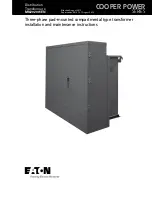
Page 7
FT-897D O
PERATING
M
ANUAL
I
NSTALLATION
G
ROUNDING
The provision of an effective ground system is important in
any successful communications station. A good ground sys-
tem can contribute to station efficiency in a number of ways:
Ì
It can minimize the possibility of electrical shock to the
operator.
Ì
It can minimize RF currents flowing on the shield of the
coaxial cable and the chassis of the transceiver which
may cause interference to nearby home entertainment
devices or laboratory test equipment.
Ì
It can minimize the possibility of erratic transceiver op-
eration caused by RF feedback or improper current flow
through logic devices.
An effective earth ground system may take several forms;
for a more complete discussion, see an appropriate RF engi-
neering text. The information presented below is intended
only as a guideline.
Inspect the ground system – inside the station as well as
outside – on a regular basis so as to ensure maximum per-
formance and safety.
Mobile Station Grounding
Although satisfactory grounding in most installations will
be achieved via the DC cable’s negative lead and the an-
tenna system’s coaxial cable shield, it is often recommended
that you provide a direct ground connection to the vehicle
chassis at the mounting location of the transceiver (installa-
tion using the optional
MMB-80
Mounting Bracket will ac-
complish this, if the
MMB-80
itself is mounted to the
vehicle’s chassis). Due to unexpected resonance which may
naturally occur in any location, improper communication
system performance may result from insufficient ground-
ing. These symptoms may include:
Ì
RF feedback (resulting in distortion on your transmitted
signal);
Ì
Unintended frequency change;
Ì
Blinking or blanking of the frequency display;
Ì
Noise pickup; and/or
Ì
ons may occur in any communica-
tions installation. The
FT-897D
includes extensive filtering
designed to minimize the chance of such problems; how-
ever, random currents set up by insufficient RF grounding
can nullify such filtering. Bonding the rear panel Ground
lug of the
FT-897D
transceiver to the vehicle or vessel’s
ground system should clear up any such difficulties.
Vertex Standard does not recommend the use of “on glass”
mobile antennas unless the shield of the coaxial cable is se-
curely grounded near the feedpoint of the antenna. Such
antennas frequently are responsible for the ground-related
difficulties described above.
Base Station Earth Grounding
Typically, the ground connection consists of one or more
copper-clad steel rods, driven into the ground. If multiple
ground rods are used, they should be configured in a “V”
configuration, and bonded together at the apex of the “V”
which is nearest the station location. Use a heavy, braided
cable (such as the discarded shield from type RG-213 co-
axial cable) and strong cable clamps to secure the braided
cables to the ground rods. Be sure to weatherproof the con-
nections to ensure many years of reliable service. Use the
same type of heavy, braided cable for the connections to the
station ground bus (described below).
Do not use gas line pipes in an attempt to provide a ground
connection! To do so creates a serious risk of explosion!!
Inside the station, a common ground bus consisting of a cop-
per pipe of at least 25 mm (1”) diameter should be used. An
alternative station ground bus may consist of a wide copper
plate (single-sided circuit board material is ideal) secured
to the bottom of the operating desk. Grounding connections
from individual devices such as transceivers, power sup-
plies, and data communications devices should be made di-
rectly to the ground bus using a heavy, braided cable.
Do not make ground connections from one electrical device
to another, and thence to the ground bus. This so-called
“Daisy Chain” grounding technique may nullify any attempt
at effective radio frequency grounding. See the drawings
below for examples of proper and improper ground connec-
tions. If your coaxial cable does not connect directly to the
station ground bus, you may connect a ground cable to the
Ground lug on the
FT-897D
rear panel.
Proper Ground Connection
Linear
Amplifier
Power
Supply
Transceiver
Improper Ground Connection
Transceiver
Linear
Amplifier
Power
Supply
"Daisy Chain"
GND
Terminal










































